 Thayer's Gull (thayeri)
Thayer's Gull (thayeri)
(last update: January 22, 2013)
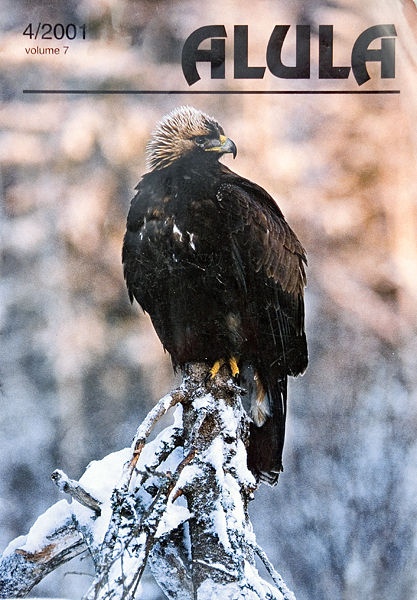 Thayer's Gull adult March
Thayer's Gull adult March
In 2001 and 2003, two extensive papers appeared in the Finnish ornithological magazine "Alula", dealing with adult Thayer's Gull and adult Kumlien's Gull. Up to now, this is by far the most extensive research on these species, and anyone interested in this topic is encouraged to get a copy of th issues. Below, you will find the content of this paper, illustrated with many digital SLR-images from various photographers and different locations.
The full title reads: Identification and Variation of Winter Adult Thayer’s Gulls with Comments on Taxonomy, by Steve N.G. Howell & Martin T. Elliott, IN: Alula 4/2001.
"we" in the text below refers to the original authors. If any errors occur in this text, please let me know and mail to marsmuusseatgmaildotcom.
Identification and Variation of Winter Adult Thayer’s Gulls
with Comments on Taxonomy
Steve N. G. Howell, Point Reyes Bird Observatory, 4990 Shoreline Highway, Stinson Beach, CA 94970, USA.
Martin T. Elliott, 36 Queen Street, St. Just, Penzance, Cornwall TRI9 7JW, United Kingdom.
The field identification of Thayer’s Gull is among the most problematic issues facing birders in North America and Europe. This enigmatic bird is variously treated as a full species, Larus thayeri (e.g., AOU 1998) or as a dark-winged subspecies of Iceland Gull, L. glaucoides (e.g., Salomonsen 1951, Macpherson 1961, Godfrey 1986, Weir et al. 2000, McGowan and Kitchener 2001), and the chequered taxonomic history of Thayer’s Gull was summarized recently by Howell (1998) and Pittaway (1999). In this paper, we use Iceland Gull only for nominate glaucoides and Kumlien’s and Thayer’s for kumlieni and thayeri types, respectively.
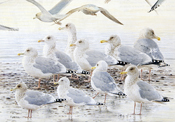 Several authors have documented the field identification of Thayer’s Gull (e.g., Gosselin and David 1975, Lehman 1980, Zimmer 1990). Increased interest in gull identification, especially of vagrants, has fuelled the fire (e.g., Garner and McGeehan 1998, Garner and Mactavish 2001), but often it seems that more heat than light is being generated. As in all large gulls, a major problem is coming to terms with the variation inherent in each taxon. In this regard, the range of variation in the characters of Thayer’s Gull and Kumlien’s Gull has yet to be defined satisfactorily. Critical published studies from the nesting grounds (with adequate samples of known breeding adults) could help clarify the characters of Thayer’s Gull.
Several authors have documented the field identification of Thayer’s Gull (e.g., Gosselin and David 1975, Lehman 1980, Zimmer 1990). Increased interest in gull identification, especially of vagrants, has fuelled the fire (e.g., Garner and McGeehan 1998, Garner and Mactavish 2001), but often it seems that more heat than light is being generated. As in all large gulls, a major problem is coming to terms with the variation inherent in each taxon. In this regard, the range of variation in the characters of Thayer’s Gull and Kumlien’s Gull has yet to be defined satisfactorily. Critical published studies from the nesting grounds (with adequate samples of known breeding adults) could help clarify the characters of Thayer’s Gull.
In the meantime, we agree with Weir et al. (2000) that, although not wholly satisfactory, wing-tip rnelanisrn appears to be the best character for distinguishing adult thayeri, kumlieni and glaucoides. Despite taxonomic uncertainty, birders often have an image of what a "typical" Thayer’s Gull and a "typical" Iceland Gull should look like - and adult birds generally do separate readily into "black-winged” Thayer’s-types and "white-winged" Iceland-types, with "grey-winged" Kumlien’s seemingly spanning all intermediate possibilities. However, Kumlien’s Gull cannot be defined satisfactorily until an attempt is made to define the characters of Thayer’s Gull (and Iceland Gull).
In this paper, we describe characters and variation in presumed adult Thayer’s Gulls wintering in central California, USA. We also discuss the separation of` adult Thayer’s Gulls from potentially similar taxa in North America and the Western Palearctic, and comment on the taxonomic status of the Thayer’s / Iceland Gull complex. Our main aim is to construct an objective, quantifiable definition that can be used to identify Thayer’s Gull in the field. We recognise that identifying gull taxa away from the breeding grounds carries an inherent implication of uncertainty; however, in this case, the wintering grounds may be at least as well defined as the breeding grounds. That is, on the breeding grounds it appears that "we can’t learn how much they [= Thayer’s and Kumlien’s] interbreed until we can distinguish them, but we can’t distinguish them because they appear to interbreed” (Howell 1998).
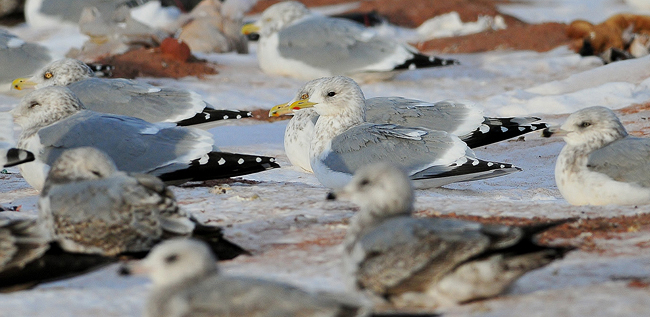
Thayer's Gull adult, January 10 2010, Duluth/Superior, Wisconsin. Picture: Karl Bardon.
Methods
Thayer’s Gulls winter mainly along the Pacific coast of North America from southern British Columbia to California, while Iceland Gulls and Kumlien’s Gulls winter mainly in the North Atlantic (AOU 1998). Adults along the Pacific coast of North America are mostly of the classic Thayer’s type: relatively large and long-billed, with “black" wing-tips and, for the purposes of this paper, we assumed that the "black-winged" types we observed in central California could be called Thayer’s Gulls.
We studied a total of 176 "adults” (see below) at close range from December 1999 to March 2000 and December 2000 to January 2001 (e.g., Photo), and recorded data on the following characters:
- Wing-tip pattern (especially primary 10 [P10, i.e., the outermost primary] and P5),
- Colour of the dark portions of the outer webs of the outer primaries, and
- Eye colour,
- As well as noting general features of size, structure, bare-part colours, and overall tone of the upperparts relative to other gulls, especially American Herring Gulls Larus argentatus smithsonianus wintering in California.
At least 70 of the birds were photographed or videotaped to allow careful analysis of 4 primary patterns. We checked all birds for signs of immaturity (especially for dark marks in the primary-coverts and tail) and restricted our analysis of characters to birds with little (n = 3) to no (n = 173) dark visible in the primary-coverts and entirely white tails. Based on studies of known-age British Herring Gulls L. a. argenteus and Lesser Black-backed Gulls
L. fuscus graellsii (MTE in prep.), we suspect that all birds in our sample were at least in their 4th winter (i.e., in 4th basic plumage and beyond) and, under field conditions, would be called adults by most birders.

Plate 2a. Wing-tip scoring criteria for P10.
Score 3: an isolated mirror separated from the pale basal inner web by a variably wide dark medial band and from the white tip by a narrow dark subterminal band.
Score 4: a variably complete white "tip" separated from pale basal inner web but contiguous with white tip.
Score 5: dark medial band incomplete; subterminal dark marks not considered in scoring.
© Martin T. Elliott.
 We paid careful attention to the possibility of confusion with hybrid Glaucous-winged Gulls L. glaucescens x Western Gulls L. occidentalis and, especially, Glaucous-winged Gulls x Herring Gulls, both of which can resemble Thayer’s Gull in plumage, but which usually differ in structural characters (e,g,, Howell and Corben 2000; also see Plate 1 and below, under Separation from Western North American Taxa). Any birds deemed to be of these hybrid combinations were not considered in our analysis.
We paid careful attention to the possibility of confusion with hybrid Glaucous-winged Gulls L. glaucescens x Western Gulls L. occidentalis and, especially, Glaucous-winged Gulls x Herring Gulls, both of which can resemble Thayer’s Gull in plumage, but which usually differ in structural characters (e,g,, Howell and Corben 2000; also see Plate 1 and below, under Separation from Western North American Taxa). Any birds deemed to be of these hybrid combinations were not considered in our analysis.
For wing-tip pattern, P10 was scored in terms of the size of the white mirror or tip and its continuity with the pale basal portions of the inner web (Plate 2a). P5 was scored in terms of presence and extent of sub-terminal dark markings (Plate 2b). lf P5 was unmarked, we checked the pattern on P6 using a similar scoring system, and if P5 had a complete black band we checked P4 for any black marks. These primary pattern scores were developed by MTE in l996 for studies of British Herring and Lesser Black-backed gulls (hence, eg., P10 scores lower than 3 are not relevant for Thayer’s Gull). Because of the difficulty in viewing P5, which on resting birds is usually covered by the tertials, we were only able to obtain complete wing-tip scores (P10 and P5) for 123 of 176 birds. ‘Sub-terminal band’ refers to a dark band just inside the primary tips, while ‘medial band’ refers to a dark band "inside” (or basal to) the mirror region (see Plate 2c). Note that exact primary patterns (especially P9 and P10) rarely can be viewed adequately in the field and are best evaluated from photos or video stills. Kodak Grey Scale (catalogue number 152-7662) calibrations were judged independently by MTE and SNGH from museum specimens. For in-field judgements, we use the term "estimated Kodak."
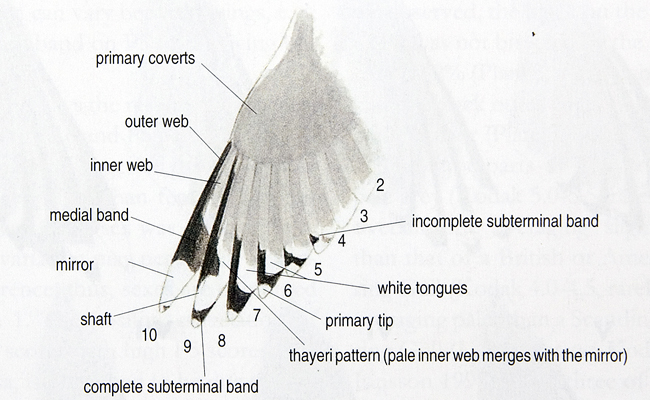
Plate 2c. Terminology used in this paper; note the distinction between subterminal
and medial bands. © Martin T. Elliott.
For the sake of consistency, we used the same scores for eye colour as King and Howell (1999). Thus, eyes were scored as follow:
0.0 iris uniformly dark brown;
0.5 medium brown;
1.0 pale brown or honey-coloured;
1.5 dusky, greenish, dark yellow, or amber, extensively mottled brown;
2.0 pale greenish or yellowish, moderately marked with brown;
2.5 pale greenish or yellowish with little or no brown mottling visible;
3.0 apparently unmarked pale yellowish (like an adult Herring Gull); in a few cases, eye colour differed between left and right eyes, in which cases we gave a mean score.
 Iris colour variation in 393 adult Kumlien’s Gull from Newfoundland and in 283 adult Thayer’s Gulls from California. Click image for table. Picture: Dave Brown.
Iris colour variation in 393 adult Kumlien’s Gull from Newfoundland and in 283 adult Thayer’s Gulls from California. Click image for table. Picture: Dave Brown.
Our experience (especially MTE) with known-sex birds of other large gulls suggests that many individuals can be sexed in the field on the basis of overall size and structure, especially when other birds are present for comparison (eg., see Ingolfsson 1969). Males average longer-billed and larger overall with slightly broader-based wings and longer tails so that they tend to show less wing-tip projection beyond the tail, and also a shorter primary projection beyond the tertial tips. Sex was inferred with reasonable confidence for 55% of our sample (59 presumed males and 38 presumed females).
Results and Discussion
First we describe and quantify variation in wing-tip pattern, dorsal coloration, and eye colour of winter adult Thayer’s Gulls, and then discuss field identification of Thayer’s with respect to potentially similar large white-headed gulls in North America and the Western Palearctic. We acknowledge that, in the light of comparable studies on the range of variation in other populations of thayeri and of kumlieni, our comments about field identification may need to be refined.
Wing-tip Pattern and Dorsal Colouration
Wing-tip pattern is often an important character in gull identification, and in this regard an appreciation of variation within each taxon is critical. The effect of age (including that of so-called "adult" birds) should also be considered, as noted long ago by Dwight (1901:60): “The question of age has not been sufficiently taken into account by the systematists who have attached undue importance to the spots and spaces of white and grey found on the wings of gulls." Thus, although Thayer’s and other large gulls are generally considered to attain fully adult or "definitive" plumage in their fourth year of life, studies of known-age British Herring Gulls and Lesser Black-backed Gulls by MTE (in prep.) indicate that wing-tip pattern can continue to change up to age seven or older (also see Poor 1946, Monaghan and Duncan 1979). In general, more white and less black develops on the wing tip with greater age. This has a potentially important bearing on the characterisation of "diagnostic” wing-tip patterns for different taxa. However, we question whether Thayer’s Gulls ever have melanism restricted to the outer 3-4 primaries, as claimed in Table 1 of Weir et al. (2000). Signs of a bird not being fully adult include dark marks on the primary-coverts, alula, and tail, and any bird showing signs of immaturity might be expected to show greater amounts of black on the wing-tip than older adults (e.g., Plate 3, a-b; Plate 4, II-III). In any claims of vagrant "adult” gulls, including Thayer’s and Kumlien’s, observers should check for signs of immaturity and consider how this might affect wing-tip pattern.
On Thayer’s, signs of immaturity in wing-tip patterns appear to resemble those shown by British Herring Gulls rather than Lesser Black-backed Gulls (MTE in prep.): that is, increased black on P9 and P10, and on the outer webs of P8 and P7. The presence or extent of blackish on P5 also appears related to age but is variable, and unreliable as a single ageing character: from Table 1, note that only 63% of birds with a P10 score of 5 (i.e., classic thayeri P10 pattern, and probably older adults) had little or no dark on P5 (scores 0 to 1). Birds with subterminal dark marks on P4 are rare and probably always younger than 4th winter (we saw no such birds in our sample, but MTE viewed one on video provided by P. Doherty).
The wing tips of perched adult Thayer’s Gulls typically (98% of our sample) appear "matt black" or "slaty black" (outer web of P10 Kodak 14.5-17; type specimen, a faded summer bird, is Kodak 15) not as dark as the jet black of a typical adult Herring Gull (outer web of P10 Kodak 18-19). Unless studied carefully, however, or without truly black-winged species present for comparison, the wing-tips of Thayer’s often appear simply “black." One of 176 birds in our sample had wing tips approaching jet black (estimated Kodak 17-18), while three others (Plate 3, m-o) had dark-charcoal wingtips (estimated Kodak 12-14).
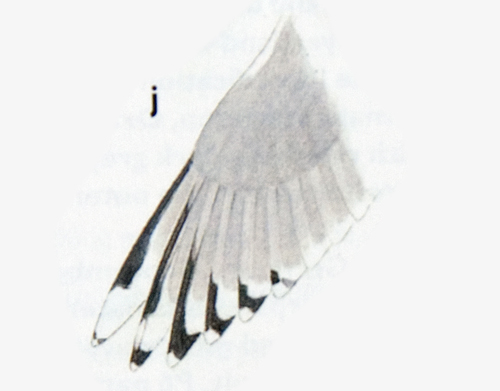 The classic adult Thayer’s Gull wing-tip pattern (as on the type specimen, MCZ specimen number 40336; Brooks 1915) is of blackish streaks on the outer webs of P8-P10 and blackish sub-terminal bands across P5-P9 (e.g., Plate 3, j, which is very similar to the type specimen). Blackish on the outer web of P8 typically extends more than half-way to the primary-coverts (the exceptions in our sample being two birds with relatively pale upperparts; Plate 3, n-o). While the extent of blackish on the outer web of P9 towards the base is variable, perhaps age-related (cf. Plate 3, j-l). The dark sub-terminal primary markings on P6-P10 typically are equally blackish across both webs, whereas dark medial bands on P9-P10 can appear slightly paler on the inner webs. The presence of a dark band on P5 has been considered a key separating point from Kumlien’s Gull (e.g., Zimmer 1991) but 25% (31 of 123 birds, including 29% of 47 inferred males and 28% of 21 inferred females) of Thayer’s Gulls we saw lacked any dark on P5, and at least 10% of these (6 of 60 checked) had incomplete blackish bands on P6 (e.g., Photo 2 in article); we saw no birds with P6 unmarked. Thus, absence of a dark band on P5 is not a reliable character for separation of Kumlien’s from Thayer’s, as noted by McGeehan and Millington (1998). Also, the dark band on P5 of adult Thayer’s is often grey and not always conspicuous in the field (e.g., sometimes it could be overlooked on a flying bird), and the pattern can vary between wings, e.g., with a dark band on P5 of one wing but not the other.
The classic adult Thayer’s Gull wing-tip pattern (as on the type specimen, MCZ specimen number 40336; Brooks 1915) is of blackish streaks on the outer webs of P8-P10 and blackish sub-terminal bands across P5-P9 (e.g., Plate 3, j, which is very similar to the type specimen). Blackish on the outer web of P8 typically extends more than half-way to the primary-coverts (the exceptions in our sample being two birds with relatively pale upperparts; Plate 3, n-o). While the extent of blackish on the outer web of P9 towards the base is variable, perhaps age-related (cf. Plate 3, j-l). The dark sub-terminal primary markings on P6-P10 typically are equally blackish across both webs, whereas dark medial bands on P9-P10 can appear slightly paler on the inner webs. The presence of a dark band on P5 has been considered a key separating point from Kumlien’s Gull (e.g., Zimmer 1991) but 25% (31 of 123 birds, including 29% of 47 inferred males and 28% of 21 inferred females) of Thayer’s Gulls we saw lacked any dark on P5, and at least 10% of these (6 of 60 checked) had incomplete blackish bands on P6 (e.g., Photo 2 in article); we saw no birds with P6 unmarked. Thus, absence of a dark band on P5 is not a reliable character for separation of Kumlien’s from Thayer’s, as noted by McGeehan and Millington (1998). Also, the dark band on P5 of adult Thayer’s is often grey and not always conspicuous in the field (e.g., sometimes it could be overlooked on a flying bird), and the pattern can vary between wings, e.g., with a dark band on P5 of one wing but not the other.
| Table 1. Correlation of patterns on P10 and P5 of 123 adult Thayer’s Gulls in central California (see Plates 2a, 2b). | ||||
| . | P10 score = 3 | P10 score = 4 | P10 score = 5 | Totals |
| P5 score 0 | 2 |
5 |
24 |
31 |
| P5 score 1 | 9 |
6 |
17 |
32 |
| P5 score 2 | 9 |
7 |
8 |
24 |
| P5 score 3 | 11 |
9 |
16 |
36 |
Totals |
31 |
27 |
65 |
123 |
Table 1 shows the results of our quantification of P10 and P5 patterns for 123 birds. Our data suggested that males may average less black than females but our sample was small, sex was only inferred, and age variation may negate any potential difference; thus, sexes are combined in Table 1. The positive correlation of low P10 scores with high P5 scores, and vice versa, is presumed to be due to age-related variation. In addition to a simple P10 / P5 quantification, complete wing-tip patterns were determined by MTE from video footage for 48 birds (Plate 3 illustrates the extremes and the commonest patterns of this sample). Of these, 48% (23 of 48) had the white tip to P10 and white mirror area on P9 contiguous with whitish on the inner webs (Plate 3, f, j-o), that is, the classic Thayer’s pattern, while 52% (25 of 48) had a complete blackish medial band on P10 (Plate 3, a-e, g-i). On P9, 96% (46 of 48; all except Plate 3, n-o) had blackish extending on to the inner web, forming a partial to complete medial band; 21% (10 of 48) had a complete blackish medial band (Plate 3, a-b, g). Thus, a dark medial band on P9 appears typical of Thayer’s Gull, contra figure 20 of Zimmer (1991) which, in our experience, shows an atypical Thayer’s pattern. Also of note (see below under Kumlien’s Gull, in Separation from North Atlantic Taxa) is that of 90 thayeri we observed, the black on the outer web of P9 was not bisected by the white mirror on 82% (Plate 3, a-g, l), whereas 18% had the black outer edge bisected by the white mirror (Plate 3, h-k).
 The upperparts of Thayer’s Gull are pale grey (Kodak 5.0-5.5, rarely 4.5), the overall tone averaging slightly darker than that of a British or American Herring Gull (Kodak 4.0-4.5, rarely 5.0), and averaging paler than a Scandinavian Herring Gull (L. a. argentatus Kodak 5.0-7.0, Jonsson 1998). Only three of 176 adults in our sample (Plate 3, m-o) appeared noticeably paler than the others, with one as pale as an American Herring Gull or Ring-billed Gull L. delawarensis. Note that in the type description, the upperparts of thayeri were reported as darker than kumlieni, paler than argentatus presumably smithsonianus (Brooks 1915). This is an error: the upperparts of the type specimen (Kodak 5.0) are, in fact, slightly darker than American Herring Gull (J. Trimble, pers. comm).
The upperparts of Thayer’s Gull are pale grey (Kodak 5.0-5.5, rarely 4.5), the overall tone averaging slightly darker than that of a British or American Herring Gull (Kodak 4.0-4.5, rarely 5.0), and averaging paler than a Scandinavian Herring Gull (L. a. argentatus Kodak 5.0-7.0, Jonsson 1998). Only three of 176 adults in our sample (Plate 3, m-o) appeared noticeably paler than the others, with one as pale as an American Herring Gull or Ring-billed Gull L. delawarensis. Note that in the type description, the upperparts of thayeri were reported as darker than kumlieni, paler than argentatus presumably smithsonianus (Brooks 1915). This is an error: the upperparts of the type specimen (Kodak 5.0) are, in fact, slightly darker than American Herring Gull (J. Trimble, pers. comm).
To summarise, the wing-tip pattern of “adult" Thayer’s Gulls wintering in California is quite variable. However, the amount of variation we observed in wing-tip pattern (if not in grey tones, cf. Plate 3, m-o), would not be surprising within a single taxon. For example, the range of variation we observed in wing-tip pattern is similar to, perhaps even less than, that found in known-age British Herring Gulls of five years or older (MTE in prep.). The three paler-mantled birds we saw with reduced “black” wing-tips (Plate 3, m-o; 1.7% of our sample) may represent introgression with kumlieni/glaucoides.
END OF PART I
 Thayer's Gull adult, March 07 2009, Lost Lagoon, Stanley Park, Vancouver, BC. Picture: Paul & David Baker.
Thayer's Gull adult, March 07 2009, Lost Lagoon, Stanley Park, Vancouver, BC. Picture: Paul & David Baker. Thayer's Gull adult, March 05 2011, Tacoma, Washington. Picture: Brian Pendleton.
Thayer's Gull adult, March 05 2011, Tacoma, Washington. Picture: Brian Pendleton.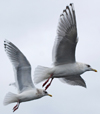 Thayer's Gull adult, March 07 2011, Parksville, Vancouver Island, BC. Picture: Guy Monty.
Thayer's Gull adult, March 07 2011, Parksville, Vancouver Island, BC. Picture: Guy Monty. Thayer's Gull adult, March 07 2011, Parksville, Vancouver Island, BC. Picture: Guy Monty.
Thayer's Gull adult, March 07 2011, Parksville, Vancouver Island, BC. Picture: Guy Monty. Thayer's Gull adult, March 07 2011, Parksville, Vancouver Island, BC. Picture: Guy Monty.
Thayer's Gull adult, March 07 2011, Parksville, Vancouver Island, BC. Picture: Guy Monty. Thayer's Gull adult, March 16 2012, Rio del Mar, CA, US. Picture: Jeff Poklen.
Thayer's Gull adult, March 16 2012, Rio del Mar, CA, US. Picture: Jeff Poklen.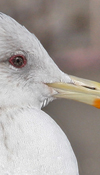 Thayer's Gull adult, March 11 2009, Capitola, CA. Picture: Jeff Poklen.
Thayer's Gull adult, March 11 2009, Capitola, CA. Picture: Jeff Poklen. Thayer's Gull adult, March 05 2010, Capitola, CA. Picture: Jeff Poklen.
Thayer's Gull adult, March 05 2010, Capitola, CA. Picture: Jeff Poklen.Identification and Variation of Winter
Adult Thayer’s Gulls
with Comments on Taxonomy
PLATES, PHOTOS & TABLES
 PLATE 1: Comparison of winter adult Thayer’s Gulls, American Herring Gull, and hybrids.
PLATE 1: Comparison of winter adult Thayer’s Gulls, American Herring Gull, and hybrids.  PLATE 2a: Wing-tip scoring criteria for P10.
PLATE 2a: Wing-tip scoring criteria for P10. PLATE 2b: Wing-tip scoring criteria for P5 patterns.
PLATE 2b: Wing-tip scoring criteria for P5 patterns. PLATE 2c: Terminology used in this paper; note the distinction between subterminal
and medial bands.
PLATE 2c: Terminology used in this paper; note the distinction between subterminal
and medial bands.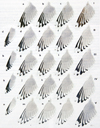 PLATE 3: "Adult" primary patterns of presumed Thayer's Gulls Larus thayeri (a-o, I) and selected Nearctic congeners (II-V).
PLATE 3: "Adult" primary patterns of presumed Thayer's Gulls Larus thayeri (a-o, I) and selected Nearctic congeners (II-V). PLATE 4: "Adult" thayeri-like primary patterns of birds filmed or photographed in Europe (primaries drawn artificially spread to show inner webs, and grey tones not reproduced accurately beyond subjective relative comparisons among examples shown).
PLATE 4: "Adult" thayeri-like primary patterns of birds filmed or photographed in Europe (primaries drawn artificially spread to show inner webs, and grey tones not reproduced accurately beyond subjective relative comparisons among examples shown).  TABLE 1: Correlation of patterns on P10 and P5 of 123 adult Thayer’s Gulls in central California.
TABLE 1: Correlation of patterns on P10 and P5 of 123 adult Thayer’s Gulls in central California. TABLE 2: Iris colour variation in 283 adult Thayer's Gulls in central California.
TABLE 2: Iris colour variation in 283 adult Thayer's Gulls in central California. TABLE 3: Correlation of iris colour and P10 score
for 102 adult Thayer’s Gulls in central California.
TABLE 3: Correlation of iris colour and P10 score
for 102 adult Thayer’s Gulls in central California. Breeds n. Canada, winters w. N. America. Vagrants reported from Japan and w. Europe. From: Chapter 36 THAYER'S GULL Larus thayeri, as published in one of the best Gull piblication: "Gulls of the Americas" by Steve Howell & Jon Dunn.
Breeds n. Canada, winters w. N. America. Vagrants reported from Japan and w. Europe. From: Chapter 36 THAYER'S GULL Larus thayeri, as published in one of the best Gull piblication: "Gulls of the Americas" by Steve Howell & Jon Dunn.
 Research area at Tomales Bay, CA.
Research area at Tomales Bay, CA. Research area at Tomales Bay, CA.
Research area at Tomales Bay, CA. Research area at Tomales Bay, CA.
Research area at Tomales Bay, CA. Indication for grey-tone in wing-tip pigmentation. The wing tips of perched adult Thayer’s Gulls typically (98% of the sample) appear "matt black" or "slaty black" (outer web of P10 Kodak 14.5-17) not as dark as the jet black of a typical adult Herring Gull (outer web of P10 Kodak 18-19). However, the wing-tips of Thayer’s often appear simply “black.".
Indication for grey-tone in wing-tip pigmentation. The wing tips of perched adult Thayer’s Gulls typically (98% of the sample) appear "matt black" or "slaty black" (outer web of P10 Kodak 14.5-17) not as dark as the jet black of a typical adult Herring Gull (outer web of P10 Kodak 18-19). However, the wing-tips of Thayer’s often appear simply “black.". 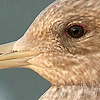 Indication for iris speckling in Thayer's Gull. Eye of Thayer's Gull adult, January 17 2004, Capitola, CA. Picture: Jeff Poklen.
Indication for iris speckling in Thayer's Gull. Eye of Thayer's Gull adult, January 17 2004, Capitola, CA. Picture: Jeff Poklen.